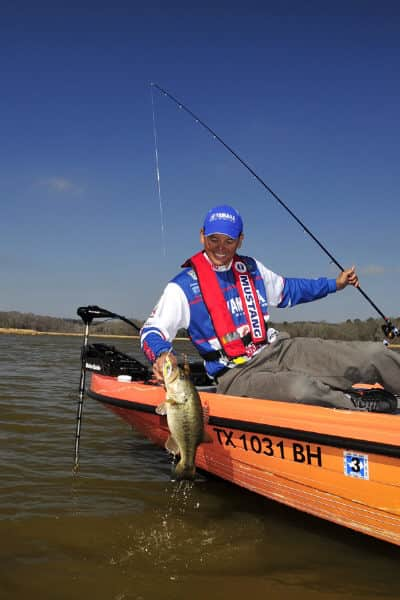Spinnerbaits Catch Bass Now During Both Shad, Bluegill Spawns
Yamaha 07.12.11

For Yamaha Pro James Niggemeyer, late spring and early summer provide some of the best opportunities of the year to catch bass in shallow water with a spinnerbait. The reason is because bream as well as shad, both prime forage for bass, have moved shallow to spawn, and bass are taking advantage of it.
“It’s all about timing,” explains the Texas-based Niggemeyer, a Bassmaster® Elite competitor as well as guide on Lake Fork, “because on many lakes, bass are already shallow since they’ve just spawned and they’re feeding actively to regain their strength. Both the bream, primarily bluegill, and shad move into the very same shallow water areas as the water temperatures continue climbing, and the bass are already there waiting for them.”
Niggemeyer’s favorite lures are either a 3/8 or ½-ounce spinnerbait, fitted with double painted willowleaf blades. When using the 3/8-ounce bait in extremely shallow water, he may opt for a Colorado/willowleaf blade combination, and if he finds bass in water deeper than about eight feet, he may choose a slightly heavier ¾-ounce tandem willowleaf spinnerbait.
 The action often begins in April and continues as late as July in different areas of the country. Bluegill beds are easy to identify, appearing as round depressions 12 to about 15 inches in diameter and crowded closely together in very shallow water. It has only been during the past several years, however, that tournament pros like Niggemeyer have realized how to identify the shad spawn, since these small baitfish do not build actual beds. Instead, they may spawn around riprap, laydown logs, and even over thick vegetation.
The action often begins in April and continues as late as July in different areas of the country. Bluegill beds are easy to identify, appearing as round depressions 12 to about 15 inches in diameter and crowded closely together in very shallow water. It has only been during the past several years, however, that tournament pros like Niggemeyer have realized how to identify the shad spawn, since these small baitfish do not build actual beds. Instead, they may spawn around riprap, laydown logs, and even over thick vegetation.
“A spinnerbait often tells you if the shad are spawning,” continues the Yamaha Pro, “because if they are, you’ll see them follow behind the lure and even nip at the skirt and blades, as if they believe they’re following another shad. Another indication the shad spawn is occurring is when you see a lot of egrets and herons standing along the shoreline. Very early in the morning, the shad will move extremely shallow and close to the bank, and the birds seem to know this.”
To determine how aggressive the bass are when he starts fishing, Niggemeyer normally begins with a steady, slow to medium speed retrieve, keeping his spinnerbait just a few inches below the surface. Then, depending on the type of reaction he has from bass, he usually lets the spinnerbait sink a little deeper, and begins shaking his rod tip to make the lure jump and appear to be struggling. He brings the spinnerbait as close to the cover as possible, even bumping it.
“You can look for shad spawning on main lake points or on primary and secondary points in large tributaries,” says Niggemeyer, “as well as around shallow vegetation, long rock walls, and even boat docks. If the surface of the water is very quiet and smooth, you may see shad flipping on the surface, but the best indication is seeing them following your spinnerbait.”
Bluegill, on the other hand, nest in many of the same types of areas bass do, including the backs of shallow coves and along protected shorelines. They build their beds in open water, rather than in moss and other vegetation, so they’re easy to see.
“Sometimes a faster retrieve with a spinnerbait triggers strikes better that slow retrieves around bluegill beds,” points out Niggemeyer, “because bass like to single out individual fish that appear to be leaving the group or the general area. I normally start with a faster retrieve, then slow down as I need to, casting beyond the beds and bringing my spinnerbait right through them.”
The Yamaha Pro admits he’s a huge fan of painted spinnerbait blades when he’s using the lures this way. He prefers silver and shad colors in clear water; chartreuse and white blades in stained water; and chartreuse and brown hues in dingy conditions.
“Even while both the shad and bluegill spawns continue for several weeks, the best fishing always takes place very early in the morning,” he concludes. “When I’m competing in a tournament and plan to fish the shad spawn, I always hope for an early draw.”

